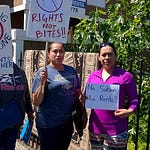About This Episode
I still remember the first time I heard Emeryville Councilmember and Vice Mayor Courtney Welch speak about housing across the lifecycle. I’m used to hearing elected officials talk about housing, often in really inspiring ways, but it’s not often that I feel like they are pushing us housers more than we are pushing them. Welch was a relatively new elected official from a small but important city that I have studied for years, pushing housers in an area that has frustrated me for a long, long time: our tendency to fight over the right kind of housing to be built, rather than embracing the fact that many, if not most of us, will want and need very different housing at different times in our lives.
We need a housing system that enables us to change, to grow up, to grow older, to combine families and households and sometimes separate them. This is something I almost never hear from housing leaders and here was an elected official showing a housing group a simple truth we often ignore.
It turns out that Councilmember Welch isn’t just an elected official: she’s a professional houser, someone who has worked across the board in our field - in policy, social work, administration, and communications. She’s worked for a truly diverse set of housing organizations, from one of Alameda County’s continuum of cares providers working to assist people struggling with housing instability and homelessness to the Bay Area Community Land Trust and her current work with the California Housing Defense Fund. She’s also someone who’s not shy about sharing her own challenges in housing and struggles with housing instability, someone who knows what it is to look for housing assistance in the Bay Area which seems to be getting more expensive by the day.
It also turns out she’s prepared to push us in a lot more than just housing across the lifecycle, no matter how important that is. She’s one of the most complete housers I have ever met, someone who tries to see the whole system, and figure out ways she can make it better no matter which of her many hats she’s wearing.
It’s an honor to have her on the second episode of Housing After Dark, the Where We Go From Here podcast. Thanks so much for joining us.
This Episode’s Guest
Interview Transcript
Alex Schafran: What does planning for housing across the lifestyle mean to you?
Courtney Welch: Housing is always thought of, or discussed as a product or industry. It is, but I think this is where people who often utilize the phrase “housing is a human right” get at the root of this: housing is a thing that you need to live. In my opinion, it’s oxygen, food, water, and housing. You will die if you do not have proper housing. Folks who are experiencing homelessness, especially those who are experiencing chronic homelessness, have a life expectancy of 50 years. Life expectancy has shifted a bit lower during the pandemic, but people are living to be 80-84 years old now. You will be missing out on almost three and a half decades of life if you don’t have proper housing.
From the day you are born to the day you die, you will need housing. It is non negotiable. You can not theoretically opt out of needing housing. Some people do opt out of housing, but most folks do not want to opt out of housing. So when I talk about housing across the lifecycle, and how having an abundance of housing available throughout communities is so important, it’s because, god willing, you live to be 94 or 104 years old. Chances are your housing needs will change for various reasons over your lifetime. Your family composition, physical abilities, and employment situation can change. So when we have an abundance of housing available in our communities, you don’t have to be worried about any changes to your life either gradual or sudden because you know there is housing available that will work whatever your situation may be.
I use myself as an example especially when talking about gradual change. I’m 35 years old. Ten years ago, I was a single adult. I had no children, my parents and grandmother were considerably younger and didn’t have certain physical issues. I could utilize a studio or a one bedroom and be completely fine. Here I am, only a decade later, and I have two children, and parents that are older; and my grandmother that has some health ailments, and potentially might need to come live with me. My housing needs are completely different from 10 years ago. I had my older son when I was 27 turning 28, and then five years later I had my second. So not even in ten years did things change.
And now, I’m in elected office. When you’re serving a community they typically want you to live there. So I am bound to Emeryville for a considerable amount of time and have to live within a certain perimeter. I have very active children so accessibility to active space is really important. When I was single I didn't need a park or access to green space. I need a more family serving unit and space.
On the other side, maybe you have a great space that does meet your needs, but you know that it is so rare to find a space that works for you so you’re worried about losing the place you do have and what you’ll do next. You potentially have people that aren’t staying in living situations that are the best because they’re worried about availability in the market.
When we talk about housing abundance and the life cycle, it’s really about stability and being able to serve people and their families and be accessible to their needs no matter how gradually or quickly they may change and make sure that a minor change in their life doesn’t completely disrupt them.
Alex Schafran: One of the next pieces I’ll write is about this relationship between stability and mobility. We have this idea that helping someone achieve housing stability is sticking them in a house and then they’ll never move again. It’s impossible!
Courtney Welch: Thinking that stability is people being where they are is forever, is not true. People being worried that they’re not going to find what they have right now, that is also a way of being trapped and vulnerable. Anything can happen and you can lose that space. Maybe there’s a fire, maybe you’re a renter where there’s a lack of tenant protections and you're vulnerable to evictions. Your needs change! What if you just don’t want to live there?
Alex Schafran: We don’t have a housing system that appreciates and values that. And it’s not just the market that thinks this way. Folks on the “good side” of housing lose sight of this housing and need for mobility, flexibility and stability. And I get it. It’s so hard to fight for the limited housing that has been made affordable that it can be hard to fight for mobility when it seems like mobility is the problem.
Courtney Welch: I think that it’s coming from a good place. If you have to choose between stability and mobility, then I need you to be stable more than I need you to be able to move. But how stable are you if you’re in one of maybe two or three options. And you’re also not the only person or family who has needs. If there are three units available, and one goes away, there’s only two left but maybe ten households in need of whatever these units are offering, so now eight households are just out of luck.
I especially understand when it comes to funding and how to prioritize what gets built where, and for whom. It’s the prioritization around stabilization. I also feel like because we are in crisis, it feels - and is - like triage. You have to pick where you go first. People are losing housing like crazy so we need to stabilize before we can dream bigger and talk about accessibility and mobility.
Alex Schafran: I want to go to your actual real day job. One of the things I admire about you is that housing is your main job, side hustle and hobby. You have one of the most varied and impressive professional housing resumes I have seen. You’ve worked for homelessness services, community land trusts, stabilization-focused housing, and more. How did you get into housing and how has that led you to where you are today?
Courtney Welch: When my older son was about 6 months old, we were displaced from where we were living in West Oakland due to an owner-move-in eviction. It was still completely legal at that time, but traumatic nonetheless. I was working part time remotely, and was making a very good part time salary, and had no issues paying the rent where I was - but then was forced out into a war zone of a rental housing market.
Studios were easily going for $2500 to $3000 a month, and they’re asking for renters to be make 2.5 to 3 times the amount of rent. I was making a good amount of money, but not making $9000 to be able to be eligible for a studio. I ended up getting some homelessness assistance from Alameda County to keep us in a hotel for a couple of weeks, but then that ran out.
At the time I didn’t have a car, so I needed to stay close to where my son was going to go to daycare. He was set to go to daycare the following month, and I was going to be working part time and making twice as much as what I was making with the good part time salary. Needing to stay in West Oakland was really important because my employment was dependent on it, and because it was where my childcare was going to be.
I was not able to find anything, so my grandmother called and said “I know it’s far away but I think you should come down here [San Diego].” She said, “You cannot be unstable with a baby that young. If you were by yourself and you said you wanted to couch surf and figure this out I’d get it, but you cannot be hopping around like this with a six months old. It’s not healthy for either of you.”
I got a ticket that night and went down to San Diego and lived down there for a year and a half while I re-stabilized. It was a really big eye opener when we came back to visit and get some things out of storage. Ten weeks after I left, hundreds of people were living underneath the freeway. I know there are always disinformation campaigns about who is experiencing homelessness. They always say they come from out of state because it’s warm here. Some of these people once lived in homes close to here. It was eye opening to see how vulnerable we all were, but especially me. I was doing everything right. I got on the waiting list while I was pregnant so I’d have childcare. I worked at a job that offered paid family leave. I was working part time and I was getting ready to get back to work. I had everything in alignment that you would expect for someone to have.
One thing happens out of my control and I’m completely destabilized. I have a lot of access and privileges. If I could get stabilized, anyone can get destabilized. It’s far too easy. That inspired me to transition into wanting to move home and work on affordable housing. I ended up getting a temporary role in April 2017 and moved back to sublet. I had then ended up moving into a transition housing shelter and living there until August of 2019, before we were able to get an affordable housing place.
Think about how much it took for me to rebuild, re-stabilize, and get my own housing from start to finish. Four years. It took four years of consistent work. When there was an opening on a waitlist for an affordable housing development, I got an application in. I used to go to the city of Oakland’s website and look for updates on construction products which would tell you that many were going to be earmarked as below market rate. I would note the properties so I could keep an eye out for who was running the problem. I signed up for everyone’s waiting list, Section 8, below market rate units. I did all this work and it still took four years.
I had a wonderful rebuilding experience being at Oakland’s Elizabeth’s Housing. And the irony is, while I was working on affordable housing, I didn’t have my own affordable housing.
What I wanted to do is not just learn what got us here, but [learn] what the pathways are out. The roles I was in can attest to this. I started off at NPH [Non-Profit Housing Association of Northern California] getting a bearing on housing policy in general, who are the building players, coalition building, how organizations support one another in changing and crafting policy. During the time I was there, they really started focusing on housing as healthcare. A lot of money from Kaiser was coming in because you can send people home with ailments, and if they’re not stably housed, there’s no way they will heal properly. Or if they have a chronic issue that requires refrigerated medication, or wounds that require you to live in a clean environment - that’s not possible if you’re on the streets.
I got to see the transition to focusing on housing as a communal issue. Housing has always been thought of as a personal matter, but it’s not. Our communities are made of residents, residents live in homes. It impacts the community whether it impacts you directly or not.
Then I moved to focus on homeownership in San Francisco working on a below market rate homeownership program.
Alex Schafran: So if anybody wants to see the research agenda of Alex Schafran, all you have to do is go to the Councilmember’s CV.
Courtney Welch: This is why you need a diverse coalition of people at the table when discussing housing issues. As a young person and the mother of a child, my big focus was on how to prevent younger people from being displaced as renters. Part of my work was working for foreclosure prevention. Black and brown seniors (people in their 80s, some in their 90s) are losing their homes or their homes are becoming unlivable. How can someone who has lived in the same home for 40 years afford any rentals or buy something else.
You saw this big transition of seniors who were once homeowners, now being thrown into housing insecurity. Some of it is the same old stuff we saw in 2008. Bad reverse mortgage loans, very predatory loan companies, very complicated contracts and when folks are in direct need of funds, a reverse mortgage can be attractive, but they have very dishonest clauses, or clauses that are not forthcoming about potential penalties. A late payment could result in you losing home.
And they are doing it very similarly to how it happened in 2008 and how we were doing it. We got a list of folks who defaulted on their home from the Assessor’s Office and did outreach to them. The loan companies are doing that too, except they are looking to make a ton of money off of you in extra fees or hoping that you default on a payment and they are able to take their home from you.
Alex Schafran: It’s tragic, truly criminal, what has happened to multiple generations of black and brown and low income homeowners in the United States. California is as bad as anywhere and that’s particularly unfortunately because we’re supposed to be “better.”
Courtney Welch: A lot of displacement has happened especially in San Francisco and the East Bay. A grandparent or great grandparent might own a home and have several family members living with them to avoid having to move further out east. A home might be keeping multiple generations of one family stable and rooted in a community. When a head of household loses a home, multiple generations of one family might be destabilized.
Alex Schafran: I’m excited to shine a light on intergenerational homeownership and all the ways homes that are owned by older generations are a bulwark against instability, homelessness and forced migrations. Your point now brings me back to when we talked about mobility, stability and housing across the lifecycle.
There are so many forces actively trying to destabilize people that you have to fight first for basic stability. That makes it harder to craft a real estate system that also enables mobility. You mentioned earlier some sort of Maslow-style hierarchy of needs. People are always going to fight for that basic stability before they fight for mobility because it seems like a luxury but it is not. We both agree that mobility should not be a luxury, but mobility and stability are often placed against each other.
Courtney Welch: The way housing has been commodified, it is seen as a vehicle to build commercial wealth. The focus is on the return on investment. People looking at a real estate portfolio don’t recognize it as peoples’ homes. This home is where people come back after a day at work, raise their children, grow old with their loved ones. It’s just a business to them, and this moves us into the rent control argument. People will say, “Well, if I can’t raise the rent X dollars, then it just pays for maintenance and I won’t make any profit off it. The whole reason I even signed up to do this was to make money off these homes.” This shouldn’t be the focus when we’re talking about housing.
You have to recognize that you’re in the business of adding scarcity to a human need. If you’re morally okay with that, then fine, but recognize that housing is not just a personal matter, it’s a communal matter. If some of us aren’t safe, then none of us are safe. We should shift to move towards a social housing model where money is paid for maintenance and does not produce a profit for someone. Or whatever profits or equity is gained is given directly back to the people living there, not just some other entity, property owner, or management company.
I really hope this is where we’re going because at the end of the day, we cannot truly say that housing is a human right if we’re always going to place the return on investment above human safety and needs.
Even the way the laws are written, your ROI is protected when you are a property owned and are renting. There are benefits even if you own your rental property but are keeping it vacant while people are dying in the streets. We need to get to a point where housing is not seen as a commodity. I really want us to look at housing like we look at food.
Alex Schafran: One of the things I think about a lot, as someone who makes their living in housing in some capacity, is the difference between making a living in housing and making excess profit that is resulting in people losing their homes. If someone comes and fixes a house, they deserve to be paid a living that affords them to buy their own house. How can we pay people to do the things we need them to do, in a way that ensures they can have housing too?
This brings me back to the question of housing professionals. When you think about your career as a houser, are there things that you want professional housers to think about differently? What is your message to the professional crowd?
Courtney Welch: What way do you want to bend the moral arc? I really think we need to get to a place where the main focus of housing is not to build wealth. Even on a personal level. People want to protect their home equity and the value of their home because they have so much riding on and invested in it.
I understand that on a surface level, but if you’re advocating for policies that are limiting where people can live or how many people can live there because you don’t want a duplex next to your single family home because you think it’s going to lower your property values, that’s a problem.
It’s even more stressful when I think about being a Black person who has been displaced and came back. There are a lot of black homeowners who subscribe to the “protect your investment at all costs” mentality, but it’s so complex. Homeownership and its relationship to the Black community is very complex.
They were impacted by redlining and all types of racial financial oppression. So when people of color who have historically been left out of building wealth through property ownership are worried about how things are going to impact their property values, how can I say this is not something you should worry about? Especially when their home is more than likely in an area that was traditionally Black and Brown and redlined. Their homes were probably devalued at a certain point anyway.
This is where I feel like policy comes into play. This is where reparations can come in, helping to right those wrongs so people who have been excluded from the process have an opportunity to balance out those past deficits and then we’re not stopping housing access for other people because we’re not worried about home values.
So if I become a homeowner, I can’t stop housing access because then I’m more than likely harming another Black person because that is who is disproportionately experiencing homelessness. It’s Black men if we’re talking about individuals, and it’s Black families, typically Black single female-led families that are experiencing homelessness.
There’s this idea in the housing space that YIMBYs are all white, not people of color. Well, to all these people make sure that you’re amplifying the voice of housers who are POC and actually listen to them. Amplify voices like mine, voices of color, female voices of color, Black people who have experienced homelessness. Make sure that they are actively part of the conversations.
Do not just prop me up by pointing out that Courtney is Black and saying the same thing as you. Actually listen to me, include me in the conversation. There are so many Black woman who are leading the conversation on all types of important housing challenges in the Bay Area. Include them, support them.
Also recognize that there is a lot of pain around housing in the Bay Area for the Black community. Yes communities change, but watching your community dwindle is really devastating for a lot of people. Then you start to feel like you don’t belong in your own home anymore.
It’s not even that other people can’t move in, but you feel like there are fewer opportunities for you to grow and thrive. When that feeling is compounded by a high cost of living and the fact that fewer of the people you grew up with are living here, you start to lose your sense of community. It’s deeper and more emotional than people realize.
Alex Schafran: Some of you may know Councilmember Welch from her past role as Housing Commissioner in Emeryville. There’s an amazing piece by Justin Phillips that features Councilmember Welch and Emeryville. It was a place that for Phillips, as a Black man, felt like a different Bay Area. Emeryville actually gained African American residents between the 2010 and 2020 Census, which is something that hasn’t happened in the rest of the Bay Area. Talk to me about this transformation in Emeryville, and about your transformation from a professional planner to an elected official who knows a lot about housing.
Courtney Welch: I grew up in Oakland. I spent a lot of time in Emeryville. I had a cousin who lived in Watergate. My parents used to go to a nightclub there. I grew up in Emeryville while it was still in its industrial stage and was starting to add housing. Even where I live now, when I was growing up this area was just old steel mills. Emeryville has had to be very creative when it comes to redevelopment and I got to see a lot of this growth happen live. I have been exposed to the changes Emeryville went through and it just comes down to the willingness of elected officials (current and previous) that prioritized housing.
On the topic of creativity - when I was running, they asked for our take on SB9 and SB10. Emeryville got rid of their single family zoning maybe at least a decade ago, and focused on transit oriented density and building around transit centers. We have our own free shuttle that will take you up to MacArthur Bart. One of the new developments is a shuttle that will take you to West Oakland.
It’s really about focusing on how to make this a livable community and transitioning it from this factory town to a community where people can thrive. Families are welcome, retirees are welcome. We have small businesses, big businesses, and we’re making it all happen within one square mile.
I think it comes down to priority. We’re not stuck, but we had to be creative with our space because we’re only one square mile. We can’t go out if we want to make our RHNA (Regional Housing Needs Assessment) numbers, we have to do multifamily housing that goes up and incorporates open space around that. We can’t just do ADU’s behind all the single family homes like a certain city tried pulling off with their Housing Elements.
We want people to be able to move here and have that balance of jobs and housing. We’re called the city of art and innovation and we have such an amazing range of innovative companies. We would love for people to live here and for the majority of folks to be able to just walk out their door and walk to work or hop on a shuttle or bike and say “I’ll be at work in maybe ten minutes.”
Having a thriving city full of people just getting to where they need to go signals that it is a healthy community where you can live and work within close proximity. The super commuter is having to come in and that’s having an impact not just on them personally, their mental and physical health, but also family structure and our environment.
In Emeryville, we prioritize this. We want to make impacts on our environment, economy, and families, in the best way and housing is a way that we can do that. Transportation is also a way we can do that. That’s part of our values system here [Emeryville].
Alex Schafran: You talk about how it’s important not just that black people can come to Emeryville, but that they can stay and sustain life in Emeryville. What are some of the most important things that you’ve done or you’re really hoping to to do to continue that process to make life sustainable for black people, people of color, low income people?
Courtney Welch: I think we need to think more about family size. I have a two bedroom, but what if a parent needs to come live with me, the boys shouldn’t have to share a room. Initially, when Emeryville was being designed, mostly studios, 1 bedrooms and 2 bedrooms were built. Very few 3 or 4 bedrooms were built.
I think the only 4 bedrooms we have aside from single family homes that might have 4 bedrooms is in Estrella Vista, but it’s income restricted (I think 30-80% AMI). That’s only for income and household composition eligible households. They typically want you to have at least 6 or 7 people in those households. That’s a lot of people. The challenge is when there are six or seven people in a household, it’s not always just two adults with four or five kids. There is typically another adult in the household composition. If they’re a senior, they might have SSI or retirement income coming in, so you might be eligible by household size but not income.
A few folks came up that were eligible for units but didn’t have the right household composition and had to get a waiver to move in. As we’re seeing more and more multi-generational family compositions, having things like 3-4 bedrooms is going to be beneficial to Emeryville.
You can start off as a single person that needs a studio or bedroom, but you can partner up, have children, have older family members move in and you know that there will be places for you to move to in Emeryville. For me, I’m advocating not just for families, but also for me. I would love for us to have more 3 or 4 bedrooms that aren’t necessarily income restricted that don’t have household composition requirements.
The folks who are pushing back against 4 bedrooms and sometimes 3 bedrooms are retirees or young people who cannot fathom needing a four bedroom. People often think it’s just college students being roommates. But even in this case - what’s wrong with that? That might actually work better because the turnover might be faster, and the unit might become available faster for a larger family.
This is really important because this has been one of the reasons why people have left Emeryville. We can make sure families can stay here longer and attract families that don’t already live here if we have more units available and online that are accessible and appropriate for a larger family size.
Alex Schafran: I couldn’t agree more. If you’re using the term “over-housed” in your vocabulary, it’s probably something you need to check. There are definitely some over-housed people but none of the ones that are impacted by housing policy. This goes back to our earlier conversation. This system is designed to be inflexible and treats people who have an extra bedroom as a problem to be solved. Maybe they would be happier in a different type of unit. This is true and it’d be great if they were able to move, but unfortunately if we don’t think about how to build more, how do we have enough housing to go around so we stop having these problems of scarcity? Having an abundance of housing is a problem I want to have. It comes with maintenance challenges but that we can solve for. Not when we don’t have enough units to begin with.
Courtney Welch: The market should always be in favor of the people who need to be housed.
Alex Schafran: The other reason that you should listen to Councilmember Courtney Welch is that she says things that are different from everyone else. I haven’t found a complete housing organization yet, but you are as complete of a houser as I have met and it is a true honor to have you on this podcast. Thank you so much for coming on and for helping make this podcast possible!















Share this post